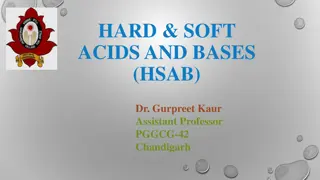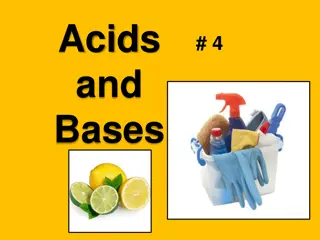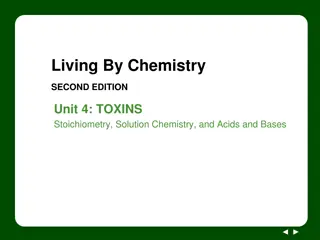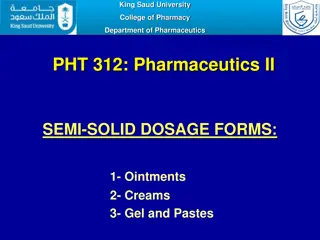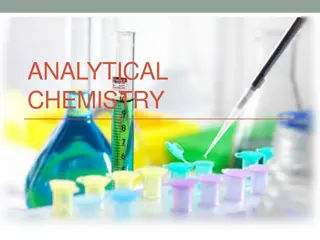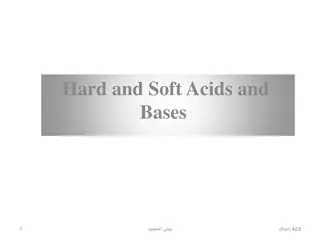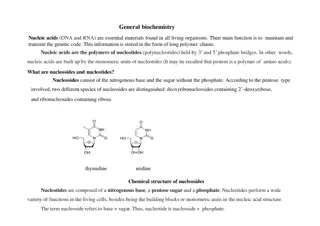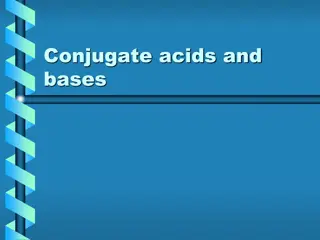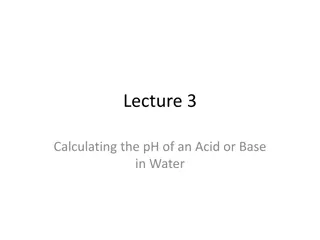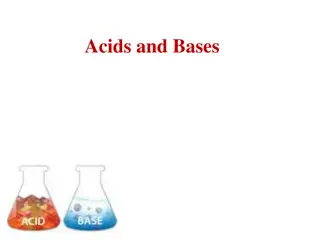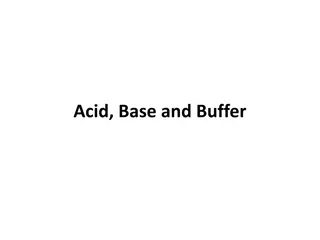Understanding Hard and Soft Acids and Bases in Chemistry
Explore the concepts of Hard and Soft Acids and Bases (HSAB) in chemistry, examining the relative strengths of acids in solution, stabilities of complexes, predictions of reaction courses, and the separation of cations based on HSAB rules. Discover how the interactions between different acid-base combinations influence chemical reactions and complex formations. Dive into qualitative analysis and the application of HSAB principles to understand the behavior of various ions in solution.
Download Presentation

Please find below an Image/Link to download the presentation.
The content on the website is provided AS IS for your information and personal use only. It may not be sold, licensed, or shared on other websites without obtaining consent from the author. Download presentation by click this link. If you encounter any issues during the download, it is possible that the publisher has removed the file from their server.
E N D
Presentation Transcript
Hard & Soft Acids and Bases B.Sc. IIIyear Dr. Prabhat K. Baroliya Department of Chemistry MLSU, Udaipur e-mail; prabhatkbaroliya@mlsu.ac.in
Application of HSAB Concepts Relative strength of Hydracids HF,HCL,HBR and HI In aqueous solution the relative strength of HF,HCI,HBr and HI can be predicted. HX+H2O H3O+ + X- Hardest base F- will combine with hard acid H+ Hence HF Will be highly stable. It is therefore least dissociated. HF < HCI < HBr < HI
Application of HSAB Concepts Relative stabilities of complexes in Aq HSAB explain that [ Cd(CN)4]2- is more stable than [Cd(NH3)4]2+. The soft acid Cd2+ will prefer to corrdinate soft base CN-. It is clear from the Kinst constants where cyano complex has Kinst = 1.4x10-19 while for ammine complex it is 7.5x10-8 . cyano complex is stable.
Application of HSAB Concepts To Predict the Course of Reaction : i) H++ CH3HgOH H2O+CH3Hg+ ii) H++ CH3HgSH H2S+CH3Hg+ The reaction (i) goes to right as the hard acid H+ binds strongly to hard base OH- to produce stable product H2O On the other hand the reaction (ii) is favoured to left where soft base SH will tend to remain combined with soft acid CH3Hg+ instead of joining to hard acid H+
STABILITY OF COMPLEX Q: Why is AgI(s) very water-insoluble, but LiI very water-soluble? A: AgI is a soft acid-soft base combination, while LiI is hard-soft. The interaction between Li+ and I- ions is not strong. AgI(s) + H2O(l) essentially no reaction LiI(s) + H2O(l) Li+(aq) + I-(aq)
Qualitative Analysis In the separation of the group cations carried out this year, HSAB rules were used to separate classes of ions based on different hard and soft interactions Group II: Hg2+, Cd2+, Cu2+, Sn2+, Sb3+, Bi3+ Group III: Mn2+, Fe2+, Cu2+, Ni2+, Zn2+, Al3+, Cr2+ Group IV: Ca2+, Sr2+, Ba2+, K+, NH4+ soft and borderline acids borderline hard acids
Separation of Cations The soft and borderline cations are separated through reaction with the soft base sulfide, S2-. Group II sulfides are less soluble than group III, so in order to selectively remove group II ions, a low pH is used: H2S(g) 2H+(aq) + S2-(aq) Even at low S2- concentrations, the group II ions precipitate (stronger interactions with the soft base, S2-) Raising the pH increases the S2- concentration, which allows the precipitation of group III ions The group IV are then precipitated as hydroxides. These cations are harder and prefer the hard base OH-.
Ambidentate Bases SCN- (thiocyanate) can interact through either its S or N atom with Lewis acids. It can donate an electron pair through more than one atom. Interaction will be through the S-atom with a soft acid, or through the N-atom when interacting with hard acids. Cr(III) interacts as Cr-NCS, while Pt(II) does so as Pt-SCN
Predict which way the following reactions will go. HI + NaF HF + NaI R AlI3 + 3NaF AlF3 + 3NaI R CaS + H2O CaO + H2S R TiF4 + 2TiI2 TiI4 + 2TiF2 L CoF2 + HgBr2 CoBr2 + HgF2 L HgO + H2S HgS + H2O R
Predict which way the following reactions will go. HI + NaF ----------- HF + NaI R AlI3 + 3NaF AlF3 + 3NaI R CaS + H2O CaO + H2S R TiF4 + 2TiI2 TiI4 + 2TiF2 L CoF2 + HgBr2 CoBr2 + HgF2 L HgO + H2S HgS + H2O R
Limitations of HSAB Concepts i) It does not provide any scale for acids and bases strength ii) The hardness and softness of A & B does not depend on the acidic and basic chararacter of compounds
Symbiosis This biological term was adopted for chemistry by J rgensen in 1964, who applied it to explain the process by which a hard ligand on a metal encourages the metal to receive another hard ligand rather than a soft ligand while a soft ligand on a metal encourages the metal to receive another soft ligand rather than a hard ligand.
Symbiosis-Explanation: A hard ligands prefers to get attached with a centre which is already linked with hard ligands. This tendency of ligands is called symbiosis
Symbiosis-Explanation: Soft ligands prefers to get attached with a centre which is already linked with soft ligands. Formation of BH4 ion by the combination of BH3(in which H atoms are soft ligands) and H ion (soft ligands).



